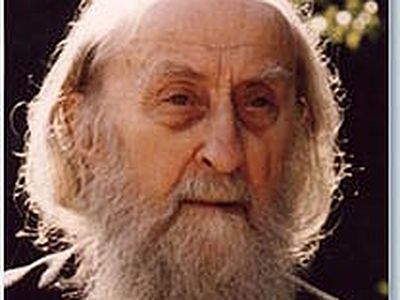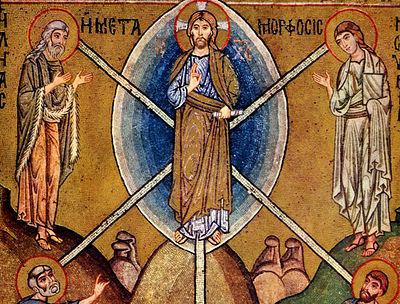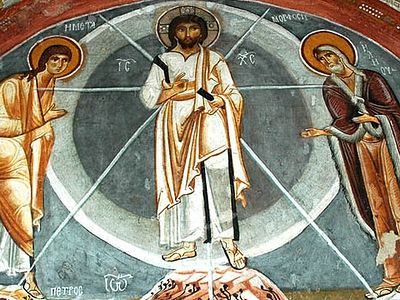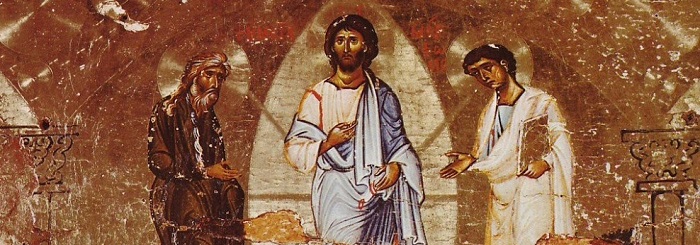
With St. John Chrysostom (c. 347-407) we have the first homily per se on the Transfiguration of Christ: Homilia 56 in Matthaeum.[1] This is the first extensive treatment of the Transfiguration since Origen,[2] and it is one which will greatly influence the homiletic tradition, and through it of course the whole liturgical and theological tradition of subsequent generations. (Chrysostom is the greatest exegete of Scripture in Patristic tradition, the homilist par excellence—he gives us about three thousand homilies on Holy Scripture—note vision seen by a disciple of St. Paul whispering in his ear).
Origen’s commentary on Matthew certainly influenced Chrysostom’s homily on Transfiguration; but as in other notable writers, such as Maximus for example, one observes the influence of Origen more in the form of a starting point, which of course Origen was in many ways. Hence we find many subtle but significant shifts of emphasis in Chrysostom’s treatment. (For further details on Origen’s contribution, see my thesis, “The Transfiguration of Christ in Greek Patristic Literature: From Irenaeus of Lyon to Gregory Palamas” Oxford D.Phil. thesis, 1991, pp. 50-72). But for the purposes of this paper, let me just say that the most important difference between Origen’s and Chrysostom’s treatment of the Transfiguration is that Origen places little or no emphasis on the Transfiguration light, owing, of course, to the strong Platonic influence on Origen’s thought.
References to the Transfiguration can also be found in other of Chrysostom’s works which also shed light (no pun intended) on Chrysostom’s understanding of the nature and significance of the revelation of Tabor.[3]
I should like to point out that Chrysostom’s treatment of the Transfiguration is extremely rich and varied, embracing a wide variety of themes (for further details, see again my thesis, ibid., pp. 99-119) which cannot be treated here in the time that we have at our disposal, at this historic first meeting of the OUPBS, so for the purposes of this seminar, I have chosen to focus on the question of the nature and significance of the Light of Tabor in St. John, also called “the golden mouthed.”
So, what does Chrysostom say specifically about the Light of Tabor?
First, I propose to examine Chrysostom’s references to the Light as supernatural, and then attempt to place what he says about the Divine Light in Chrysostom’s own gnosiological context, which will enable us to assess its nature and significance more accurately.
But let us first read the texts pertaining to the light of Transfiguration in the Synoptic Accounts:
For St. John Chrysostom the Transfiguration is primarily an eschatological revelation. (This perspective may be traced back to Irenaeus of Lyon, with the eschatological vision of Christ resplendent in the Paternal light—examined in my opus magnum, ibid., pp. 37-43). So as to prepare His disciples for the trials that they were about to endure in this life (cf. John 16:33), Christ chose to give them a foretaste, concrete proof, of the heavenly blessings of which he had hitherto only spoken:
These [trials] were in the present life and at hand, while the good things were still in hope and expectation; as in for example, they save their life who lose it; His coming in the glory of His Father, to render His rewards. But willing to assure their very sight, and show what kind of glory it is with which He will appear (deixai tes pote estin he doxa ekeine, meth’ hes mellei paraginesthai), so far as they were able to understand this (hos enchoroun en autois mathein), even in this present life He shows and reveals it to them.[4]
The one thing of which Christ had only spoken, but which had not been revealed until the Transfiguration, was His coming again in the glory of His Father (en te doxe tou patros autou, cf. Matt. 16:27). The above passage indicates that the glory of the transfigured Christ is a foreshadowing of the Paternal glory in which Christ is to appear at the Last Day.
However, in another passage Chrysostom states clearly that the righteous at the Last Day will see Christ, not merely as His disciples had seen Him on Tabor, but “in the very glory of the Father” (en aute tou patros te doxe).
For not thus shall He come hereafter. For then, so as to spare His disciples, He disclosed only as much of His brightness as they were able to endure; whereas later He shall come in the very glory of the Father, not only with Moses and Elias, but also with the infinite angelic hosts, with archangels, with Cherubim, with those infinite heavenly companies.[5]
Thus, “the very glory of the Father,” which is here referred to as an even greater glory than that which was revealed at the Transfiguration, will be revealed only at the Last Day. What, then, is the difference between the glory of Christ at the Transfiguration and the glory of the Second Coming?
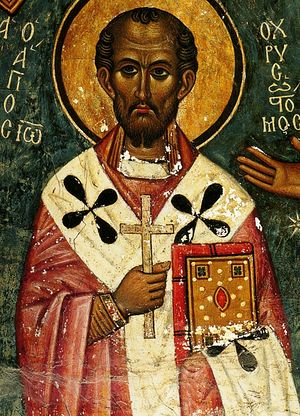 St. John Chrysostom
St. John Chrysostom
(As mentioned earlier, Chrysostom’s position here greatly resembles that of Irenaeus, who, when speaking of the glory of the Millennium and that of the Kingdom of Heaven, makes no qualitative distinction and speaks of the same Paternal glory).
But while Chrysostom does regard the Transfiguration as a genuine eschatological revelation, nevertheless in terms of scale he does not see it as a perfect or accurate manifestation of the glory of the future Kingdom (ouk epideixis tou pragmatos akrives).[7] Even the light of Tabor, he says, can only be but a dim image of the future things (amudran tina ton mellonton eikona).[8] For only at the Last Day shall we have a “face to face” vision of the Incarnate Word.[9] At His Second Coming, therefore, the righteous will see Christ, “not as they then on the mountain, but in far greater brightness (alla pollo lamproteron). For not thus shall He come hereafter. For whereas then, to spare His disciples, He discovered so much only of His brightness as they were able to endure.”[10] Significantly, Chrysostom also explains why this has to be so:
The glory of incorruptible bodies does not emit a light similar to that of this corruptible body (ou tosouton afiesin to fos, hoson touto to soma to phtharton), nor is it of a kind which is accessible to mortal eyes, but incorruptible and immortal eyes are required in order to see it. For then on the mountain He revealed only so much [of this light] to them as was possible for the beholders’ eyes to see without being afflicted; yet even so they could not bear it and fell on their faces.[11]
So the glory that was revealed on Tabor, the glory of Christ’s divinity, is the very same glory that the incorruptible bodies of the righteous will receive in the Celestial Kingdom. This glory is perceived as light. But this light, says Chrysostom, which will be revealed more fully at the Last Day, is not a natural or physical light, for it is not “accessible to mortal eyes.”[12] The reason why, then the three disciples were unable to bear even the glory revealed at the Transfiguration was because the supernatural and immaterial nature of this light is fully perceptible only to incorruptible and immortal eyes.[13] It is important to note here that this was according to Chrysostom a vision which the apostles actually saw with their bodily eyes, even if only in an imperfect manner—hence their physical reaction to it. But even though the three disciples actually saw Christ transfigured by His divine glory, they were nevertheless unable to contain the vision because, as St. John explains, they were still subject to corruption and death.
This highlights another important aspect in Chrysostom’s appreciation of the significance of the Transfiguration: that of the glorification of the human body. He explains:
Because the word concerning the Kingdom was until then unclear to those that heard it … He was transfigured before His disciples, thereby revealing to them the glory of the future things and, as in an enigmatic and dim way, showing what our bodies will be like. And whereas then He appeared with garments, it will not be so at the resurrection. For our body will need either garments, nor abode, nor roof, nor any other such thing.[14]
Thus the Transfiguration is proof that the human body will also be transfigured at the General Resurrection. According to Chrysostom, the whole human person, body as well as soul, has been called to participate in the glory of which the Transfiguration is but a humble foreshowing.
Let us now turn to the gnosiological context in which we should understand the revelation of God in Chrysostom. Firstly then, St. John insists that a clear distinction should be made between those things pertaining to God Himself (ta tes theotetos) and those thing pertaining to God’s action or operation in the world (ta tes oikonomias).[15] In reference to this distinction Chrysostom first emphasizes the immutable and inaccessible nature of God:
Most high was He, and lowly was [His economy]; Most high, not in locality, but in nature (ou topo, alla physei). He was uncompounded, His essence indestructible, His nature was incorruptible, invisible, incomprehensible, always being, the same being, beyond angels, superior to the heavenly powers, surpassing reason, transcending the intellect, being impossible to see, [He was] simply believed in.[16]
God in Himself, in His essence and nature, is invisible (aoratos) and incomprehensible (aperinoetos), and as such can neither be seen (ophthenai me dynamenos) nor comprehended (nikon logismon hypervalnon dianoian).
But is this is so, how does God reveal Himself to man? Chrysostom answers wit the following:
When He wishes to show Himself, He does not appear as He is, nor is His bare essence revealed—for no one has seen God as He is; for at His condescension even the cherubim trembled; He condescended, and the mountains smoked; He condescended and the sea dried up; He condescended, and Heaven was shaken (for had He not condescended, who could have borne it?). Therefore, He appears not as He is, but as that which the beholder is able to see; that is why He sometimes appears aged, and sometimes young, sometimes in fire, and sometimes in a breeze, sometimes in water, and sometimes in weapons, not changing His essence, but fashioning His appearance according to the different circumstances (schematizon ten opsin pros ten poikilian ton hypokeimenon).[17]
The key word in Chrysostom’s description of the economy of God is condescension (sygkatavasis),[18] for it is by His condescension that God reveals Himself to man. He does this, says Chrysostom, not by suffering change in His essence, but by conforming, shaping or adapting Himself[19] to the capacity of His creature, Chrysostom is not here referring to created effects in God’s revelation to man, for sygkatavasis denotes the loving descent and participation of God Himself in the life of His creature.[20] So, it is precisely God’s sygkatavasis which reveals His love for mankind (philanthropia), and which finds its ultimate expression in the Incarnation—the hypostatic condescension of the Son and Word of God.
Here we find a remarkable resemblance between Chrysostom’s concept of condescension and the Cappadocian, particularly the Basilian, distinction between the essence and energies of God.[21] As far as I am aware, this distinction, just as in St. Basil’s, is made explicit a single passage (in the De incomprehensibili dei natura 1.5 SC28), where indeed the word “economies” is used rather than “condescension.” Here, Chrysostom in reference to St. Paul’s passage on the partial knowledge of God, simply says of St. Paul that “he does not say this of the essence, but of the ecomomies” (ou peri tes ousias touto legei, alla peri ton oikonomion).[22] Given the created-uncreated distinction which is also to be found in Chrysostom,[23] the antithesis is clear: while in Basil we find the schema essence-energies, in Chrysostom there is the schema essence-economies (or condescension): the meaning, however, is the same.[24] Neither of these two great Fathers develops the theme further; indeed in both instances there main concern was to refute the claim of the Anomoeans (the followers of Aetius and Eunomians) that human reason and the human intellect are capable of penetrating into the divine mysteries to the point of apprehending even the essence of God. And as we know, it is only in the fourteenth century that the full significance of this distinction is made clear by the Hesychasts.
The Transfiguration, then, clearly falls within the realm of ta tes oikonomias. As such it is yet another example of the sygkatavasis of God. On Tabor the pre-eternal divine glory manifested in and through the theandric Christ appears to Peter, James and John as a brilliant light. Now with the benefit of what we have learned about Chrysostom’s gnosiological framework, let us look at what he says about the language of Scripture in the description of the divine light of Tabor:
When He wishes to say something about Himself, He uses human images. As for instance, He went up to the mountain, and was transfigured before them, and His face shone as the light, and His garments became white as snow. He revealed, he says, a little of His divinity, He showed them the indwelling God … The Evangelist, then, wanted to show His brilliance, and so he says, He shone. How did He shine? Tell me. Exceedingly. And how do you say? As the sun … Why do you say so? Because I have no other star brighter. And He was white, as snow. Why as snow? Because I have no other matter whiter. That He did not shine in this way is indicated by the following: And the disciples fell to the ground. If He had shone as the sun, the disciples would not have fallen (for they saw the sun every day, and did not fall); but because He shone more than the sun and more than the snow, that is why, unable to bear the brilliance, they fell down.[25]
The revelation on Tabor demonstrates that the language which Scripture employs in order to describe the revelation of God to man should not be interpreted literally, but rather it should be understood in a manner befitting God (theoprepos).[26] As he puts it in another passage, we should raise our minds to the meaning that the words of Scripture try to convey.[27] According to Chrysostom, therefore, Scripture likens the light of Tabor to the sun and snow because there is nothing brighter within the realm of human experience to which this particular light could be likened. (Note that Chrysostom, like Diodore of Tarsus, was opposed to the allegorical interpretation of Scripture, which makes his interpretation here all the more striking—so St. John is not interested here in metaphor or figurative language.)
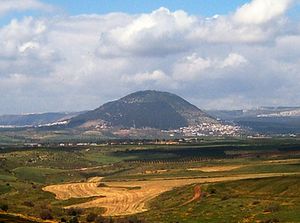 Mt. Tabor
Mt. Tabor
However, there is in Chrysostom no explicit statement regarding the nature of the Cloud beyond what has already been said, namely, that it is simply a manifestation of God. But there is a small passage in his homily on the Transfiguration, which offers, perhaps, a more positive indication of what Chrysostom believes the bright Cloud to be. He says, “There is probably nothing more blessed than the apostles, and especially the three, who even in the Cloud were made worthy to be under the same roof with the Master.”[32]
Of course, the general point being made here is that there can be no greater blessing for us than to be with Christ. The context of this passage, however, is eschatological. Being with Christ, then, is the blessing that the apostles received, and it is also the one thing that all Christian should strive and hope for. But there is also a strong emphasis here on the three disciples, who received the extra special distinction of being with Christ even in the Cloud (ka en te nephele). What, then, is the significance of being in the Cloud? On one level, it is possible that Chrysostom is simply making a statement of fact: Peter, James and John were with Christ more often even than the other apostles—even, that is, in the Cloud. While this is undoubtedly true, it still does not offer a satisfactory explanation of this passage, because it does not take into consideration either the strong eschatological perspective of the passage in general, or the special emphasis which Chrysostom places on the Cloud in particular. Perhaps a better explanation, therefore, would be that the three disciples were indeed blessed to be in the Cloud with Christ, because this was a further and deeper revelation of the Celestial Kingdom. This harks back to the Cloud as the Tabernacle of God—a place where God is. In the Cloud, then, the three disciples experienced the heavenly bliss of the righteous—the blessed life of the future Kingdom.[33] This would imply, therefore, that the bright Cloud is not merely an indication of the presence of God, but that it is itself a description of the three disciples’ participation in the Life of God.
In conclusion, therefore, we can say that the theological implications of the Transfiguration of Christ in Chrysostom are predominantly eschatological. Its significance lies chiefly in that it reveals the future blessed state of the righteous in the Kingdom—the glory of the Father. The glory of the Transfiguration is not qualitatively inferior to that of the Kingdom, but its magnitude is no a far humbler scale than that of the Last Day. Moreover, it also shows that the human body, despite its incapacity prior to the General Resurrection to bear the full experience of the divine glory, is clearly intended to participate fully in that same glory in the Age to Come. This eschatological glory is manifested on Tabor as Light which cannot be compared with any created light known to man. The gnosiological framework, into which Chrysostom places the Light of Tabor, demonstrates that even descriptions of the revelations of God in Scripture are ultimately always apophatic in character. The Taborian Light, then, is not a physical or material light, and cannot be perceived fully by the corruptible physical eyes of mortal man. Therefore, although he never refers to the Transfiguration Light specifically as uncreated (aktiston), it is not difficult to appreciate how these factors combine to point to its supernatural and—because of His clear-cut created-uncreated distinction—also uncreated nature. Equally significant in Chrysostom’s treatment of the Taborian theophany is his insistence on the revelation of God by His condescension rather than by His essence or nature, which is not only invisible and incomprehensible but also totally inaccessible to both human reason and intellect. Indeed, as we shall see, the fundamental presuppositions as regards the relationship between the Light of Tabor and the divine economy are remarkably similar to those which may be found in Greek patristic literature throughout the period which this study aims to cover, that is, up to and including the person of St. Gregory Palamas in the fourteenth century.
The Cloud, on the other hand, offers the disciples a deeper experience or foretaste of the life of the blessed in the Kingdom of Heaven. And the words of the Father, by informing us of the hypostatic individuality and uniqueness of the Son’s generation from Him, transport us once more to the plane of the life of the Holy Trinity—the Kingdom of Heaven.
* * *
Originally published in: Veniamin, Christopher. "Saint John Chrysostom and the Light of Tabor." Patristic & Byzantine Society (Merton College, University of Oxford: Hilary Term, 1994). Published in Alive in Christ X.2 (Summer 1994): 29-33.

